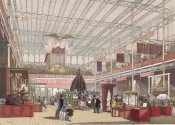Exhibited at the Great Exhibition, London, 1851
Exhibited at the Great Exhibition, London, 1851
John Grant consented to lend his Greek Slave to the Great Exhibition of the Works of Industry of All Nations, which opened at the Crystal Palace in Hyde Park, London, in 1851. The request for the loan was made by N. S. Dodge, the United States Commissioner for the American section. As at Henry Graves in 1845, the statue was placed on its rotating pedestal in a curtained gazebo. It became the major attraction of the United States exhibit, and its dramatic presentation was recorded in many prints and engravings.[1] (This is further discussed in Martina Droth’s essay.)
[1] Martina Droth, Jason Edwards, and Michael Hatt, eds., Sculpture Victorious: Art in an Age of Invention, 1837–1901 (New Haven: Yale University Press, 2014), 315–22.

![After John Absolon, “View in the East Nave (The Greek Slave, by Power [sic]),” *Recollections of the Great Exhibition of 1851* (London: Lloyd Brothers, 1851). Hand-colored lithograph by Day & Son. The Metropolitan Museum of Art, New York. After John Absolon, “View in the East Nave (The Greek Slave, by Power [sic]),” *Recollections of the Great Exhibition of 1851* (London: Lloyd Brothers, 1851). Hand-colored lithograph by Day & Son. The Metropolitan Museum of Art, New York.](https://interactive.britishart.yale.edu/sites/default/files/styles/ycba_thumbnail/public/1851%20Greek%20Slave%20by%20Absolon%20Met%20coll_0.jpg?itok=1IKAzwi0)
![“The Greek Slave, by Hiram Power [sic],” *Exhibition Supplement to the Illustrated London News* 19, no. 509 (August 9, 1851), front cover. Wood engraving. Yale Center for British Art, New Haven. “The Greek Slave, by Hiram Power [sic],” *Exhibition Supplement to the Illustrated London News* 19, no. 509 (August 9, 1851), front cover. Wood engraving. Yale Center for British Art, New Haven.](https://interactive.britishart.yale.edu/sites/default/files/styles/ycba_thumbnail/public/Exhibition%20Supplement%2C%20London%20illustrated%20news%20vol%20XIX%20No.%20509%2C%20August%209%2C%201851%2C%20p.%20185_1.jpg?itok=bx6E9egj)
